Coronavirus Today: A convoy to chaos?
- Share via
Good evening. I’m Karen Kaplan, and it’s Friday, Feb. 11. Here’s the latest on what’s happening with the coronavirus in California and beyond.
Maple syrup. Trivial Pursuit. Justin Bieber. And now ... “freedom convoys.”
Canada’s latest contribution to global culture doesn’t seem very Canadian at all. Our neighbors to the north are famous for their supreme politeness, and the truckers mounting blockades in Ottawa are anything but considerate.
The big-rig drivers first descended on the Canadian capital about two weeks ago to protest the government’s COVID-19 vaccine mandate and other pandemic restrictions. Residents say they feel unsafe, and Ottawa Mayor Jim Watson declared a state of emergency.
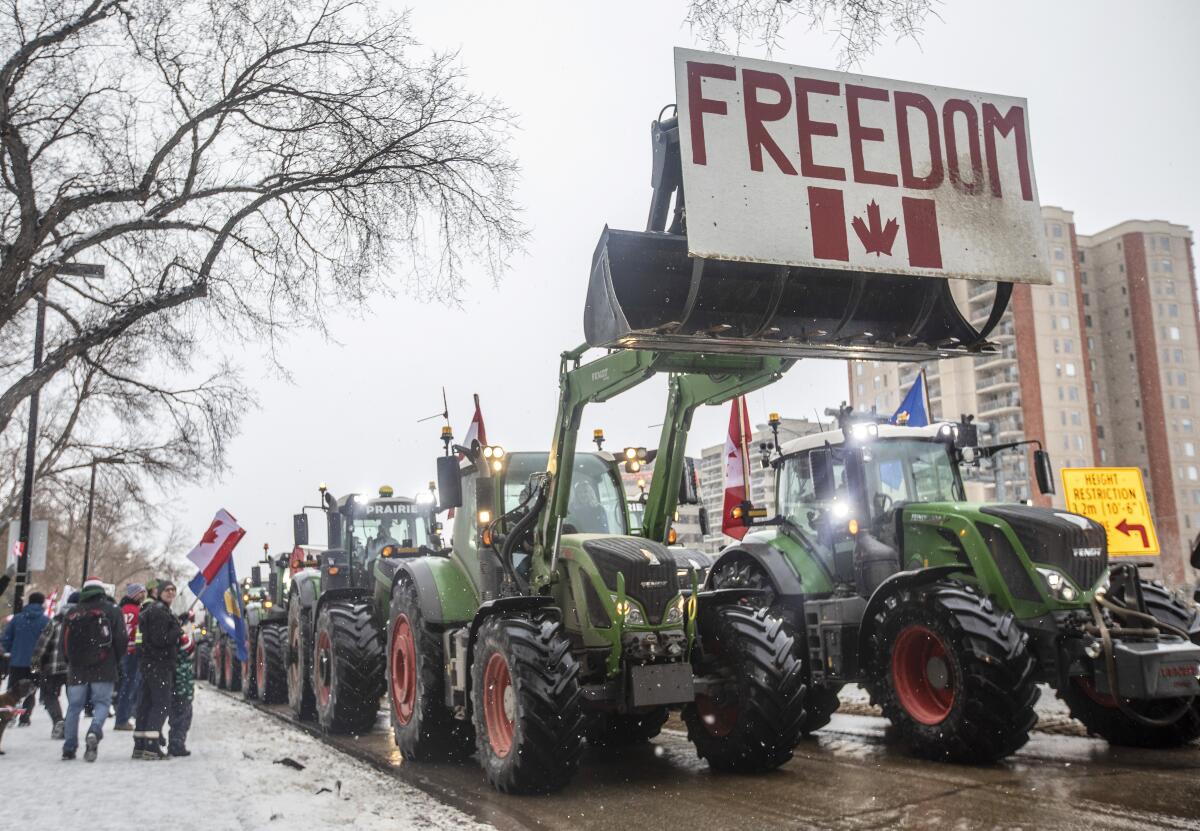
The bumper-to-bumper protests have spread to other parts of Canada. Demonstrators paralyzed traffic on the Ambassador Bridge that connects Windsor, Ontario and Detroit, forcing General Motors and Ford to shut factories on both sides of the border because needed parts couldn’t get through and prompting Ontario Premier Doug Ford to declare a state of emergency of his own. Two other border crossings have been brought to a standstill as well.
And they’re spreading beyond Canada. The U.S. Department of Homeland Security has warned hundreds of police agencies that truckers are planning a convoy that might travel from California to Washington, D.C., potentially disrupting large cities along the way. Some would-be participants have been using the messaging app Telegram to work out the logistics, including stocking up on supplies like food and toiletries along the way.
There have also been calls for a truck protest at Sunday’s Super Bowl at SoFi Stadium in Inglewood, though it doesn’t look like those calls have gained momentum, my colleague Richard Winton reports.
In France, convoys of vehicles from around the country are converging on Paris, with some drivers planning to continue to Brussels, where the European Union has its headquarters. More than 300,000 people are following the movement on Facebook.
Half a world away, thousands of truckers blocked roads in New Zealand’s capital city of Wellington and waved signs reading “Take Back Our Rights” and “No More Mandates.” Hundreds of protesters in Australia are planning to keep their “Convoy to Canberra” going through the weekend at least.
Republican politicians in the U.S. are some of the most vocal supporters of the convoy movement. Former President Trump said Canadian Prime Minister Justin Trudeau had “destroyed Canada with insane COVID mandates,” while Texas Sen. Ted Cruz told any Canadians tuned into Fox News that “government doesn’t have the right to force you to comply to their arbitrary mandates.”
That sentiment is shared by Daniel Koors, a Purdue University graduate who became a trucker 13 years ago and was planning to join a convoy.
“We’re tired of giving up our rights as free people to do what we want,” Koors told my colleagues. “That’s what this entire convoy is all about: It’s to bring attention to the government that the American people are tired of being walked upon.”
The vocal GOP endorsements have some experts fretting that the U.S. could be in for a new round of Jan. 6-style attacks. Law enforcement officers in Washington, D.C., were quickly overwhelmed by the violent mob that stormed the U.S. Capitol last year, and police departments in other American cities could be overmatched by protesters with large vehicles who are looking for a way to vent their frustration with pandemic restrictions.
“An initial reluctance to enforce the law against these far-right protesters has the potential to lead to disaster,” said Mark Potok, a former senior leader at the Southern Poverty Law Center. “In both Canada and the United States, these lawless convoys are engaging in tactics that are not only patently illegal but also have a very real potential to escalate into a direct challenge to democracy itself.”
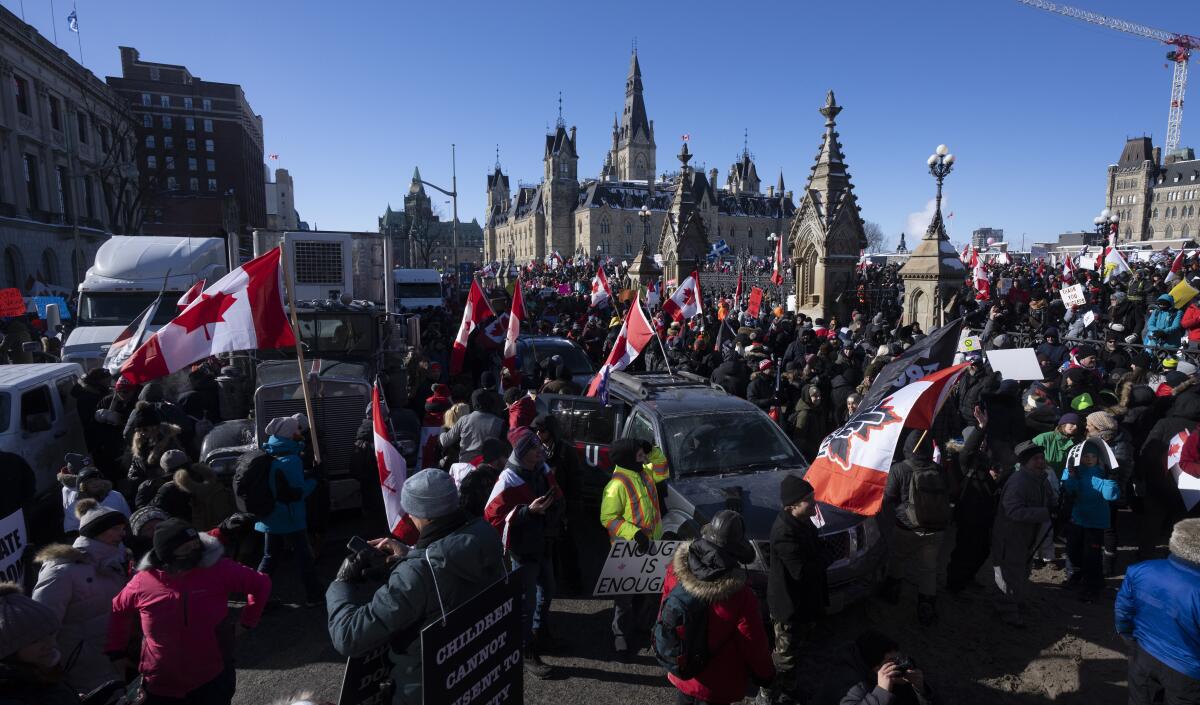
If you think that sounds like hyperbole, just listen to the truckers in Canada. They’ve pledged to stay put in Ottawa until Trudeau resigns and the vaccine mandates and other COVID-19 restrictions are rescinded.
That’s not gonna happen, Trudeau insists. He gets why the protesters are upset, but holding cities hostage isn’t the solution, he said.
“This pandemic has sucked for all Canadians,” he said. “But Canadians know the way to get through it is continuing to listen to science, continuing to lean on each other.”
By the numbers
California cases and deaths as of 5:15 p.m. Friday:

Track California’s coronavirus spread and vaccination efforts — including the latest numbers and how they break down — with our graphics.
Too much of a good thing
If something is good — chocolate, money, free time — then more of it is better, right?
Not when that something is choice.
You’ve probably learned this the hard way during the pandemic. Decisions that used to be no-brainers suddenly became fraught. Can my 12-year-old have a birthday party? Is it OK to open the front door if someone knocks? Should I cancel a long-planned trip even though I won’t get my money back?
Without experience to fall back on, figuring out what to do in situations like these takes a lot more mental energy. To make matters worse, the risk-benefit calculations we perform to help us make up our minds include so much uncertainty that we’re bound to second-guess ourselves. It’s exhausting.
The stakes are higher too. Deciding whether to dine in a restaurant or order a meal to go can almost feel like a matter of life and death.
Psychologist Barry Schwartz has a name for the feeling we get when all these choices leave us utterly drained: decision fatigue.
“When you overwhelm people with options, instead of liberating them, you paralyze them,” Schwartz explained to Jenny Gold, who writes for our friends at KHN. “They can’t decide. Or, if they do decide, they are less satisfied, because it’s so easy to imagine that some alternative that they didn’t choose would have been better than the one they did.”
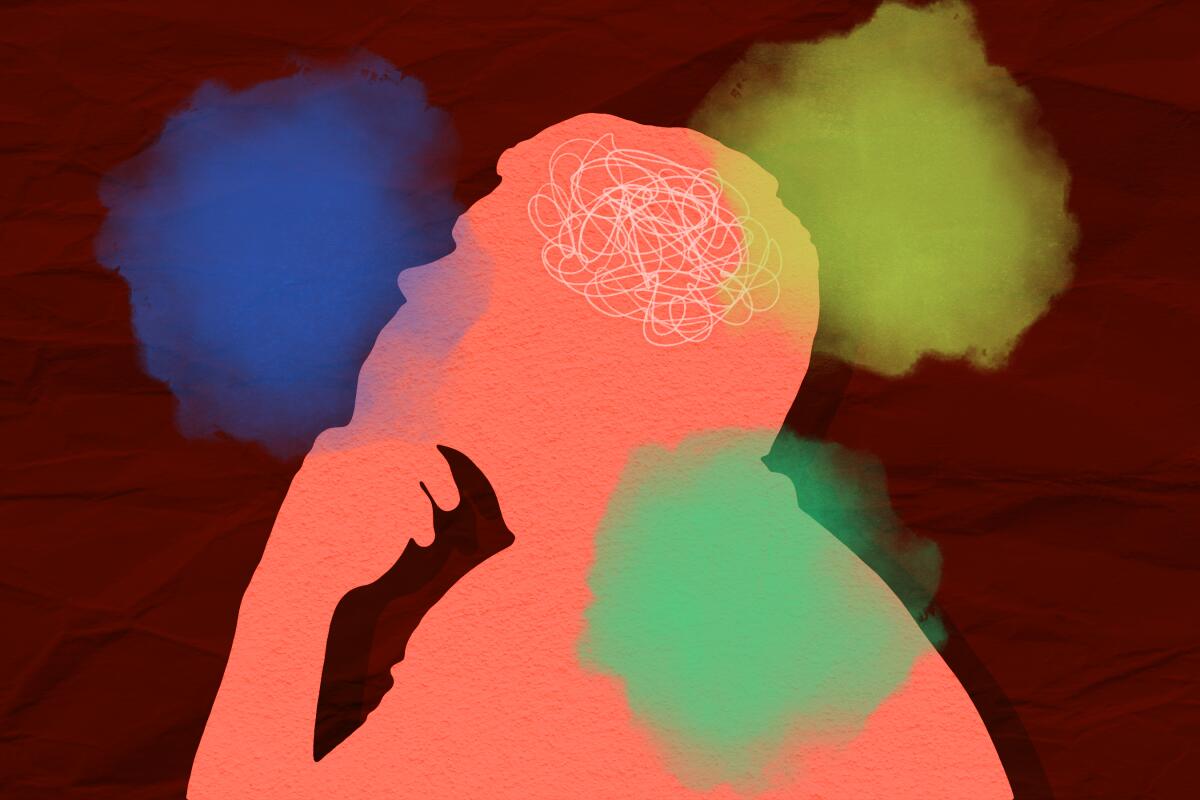
Schwartz has been thinking about this phenomenon since long before the COVID-19 pandemic. But a pandemic certainly makes the problem worse.
“These are not decisions we’ve had practice with,” he said. “And having made this decision on Tuesday, you’re faced with it again on Thursday. And, for all you know, everything has changed between Tuesday and Thursday. I think this has created a world that is just impossible for us to negotiate.”
Schwartz wrote an entire book about decision fatigue, so he’s qualified to offer two pieces of advice about how to avoid it.
The first is to set some rules so you’ll have fewer decisions to make. You probably do this already — when you run out of toothpaste and head to the store, you don’t examine all the options on the shelf before putting one in your cart. Most likely, you buy the one you already like well enough.
The same goes for the pandemic. You can decide to stay out of movie theaters for the next three months, for instance. That rule may be overly conservative, and you may miss out on some fun times, he said. But simplifying your life by taking that decision off the table will have its own rewards.
Schwartz’s second suggestion is not to let the perfect be the enemy of the good.
“Stop asking yourself, ‘What’s the best thing I can do?’” he said. “Instead, ask yourself, ‘What’s a good enough thing I can do?’”
If you cut yourself a little slack, you can make safe decisions with a lot less stress.
California’s vaccination progress
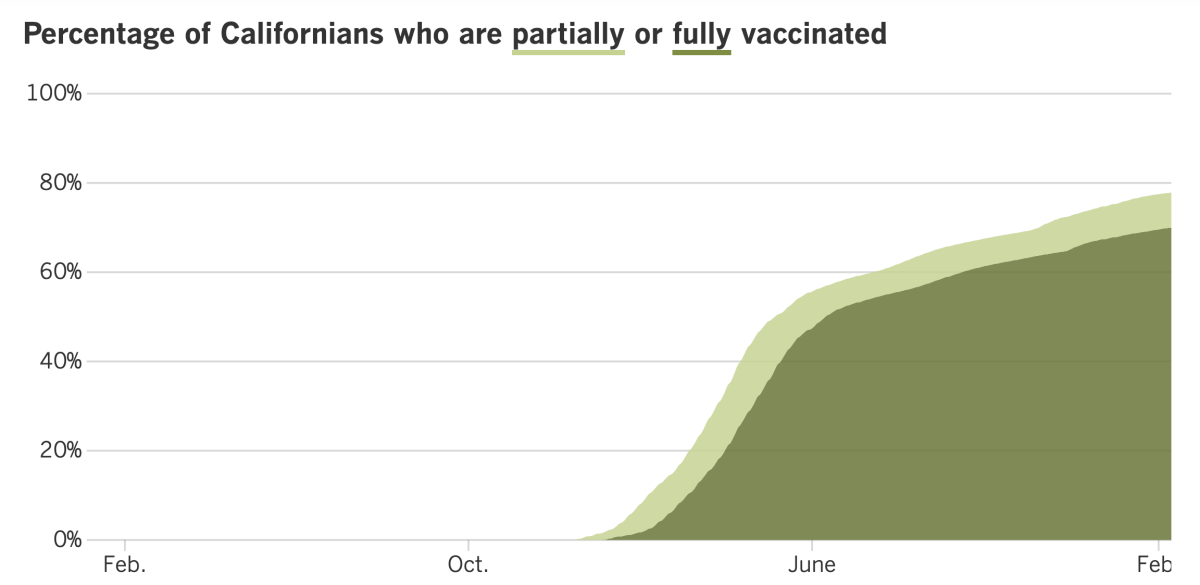
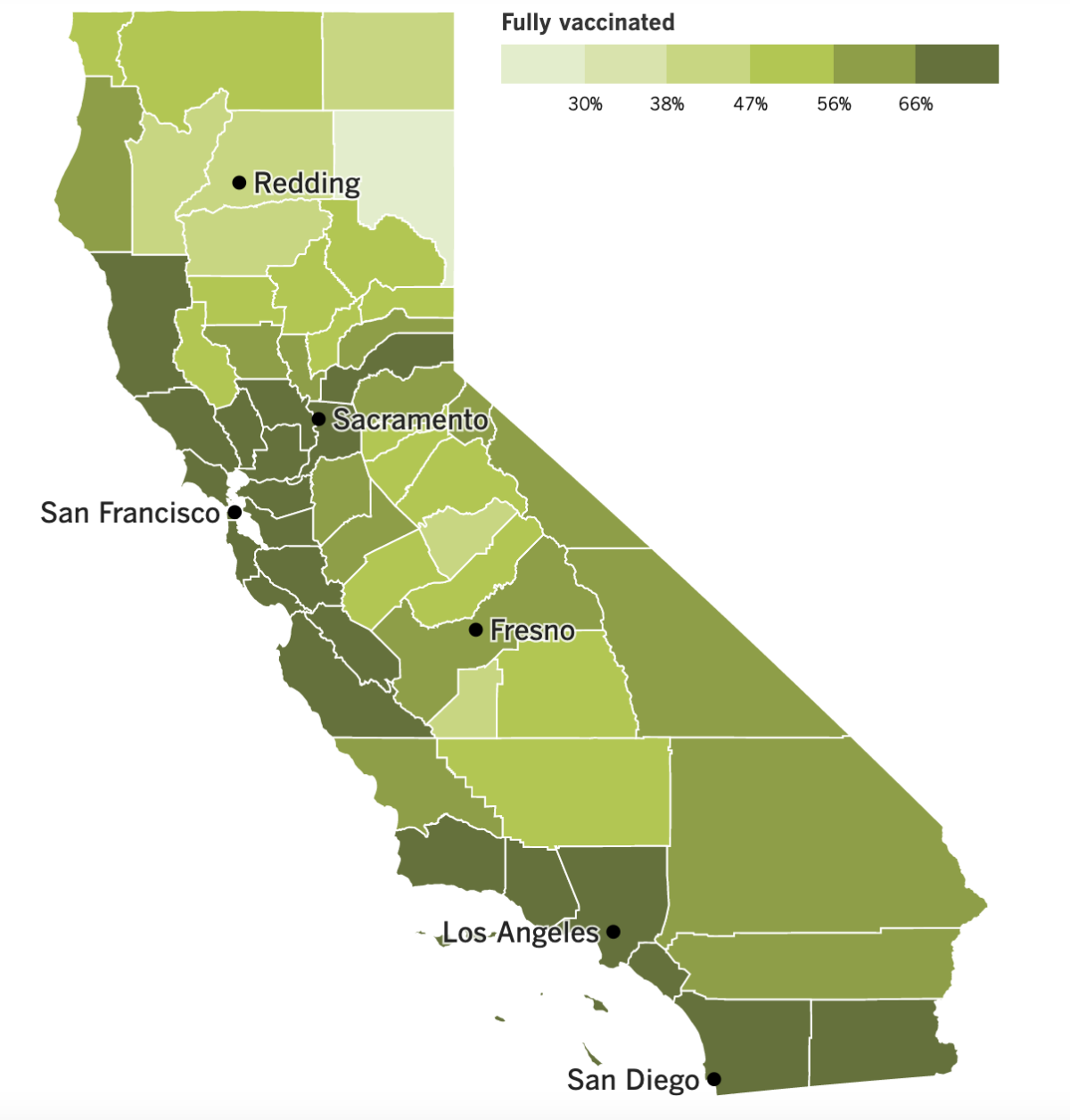
See the latest on California’s vaccination progress with our tracker.
Your support helps us deliver the news that matters most.
In other news ...
Will Sunday’s Super Bowl become a “Super-spreader Bowl,” as Los Angeles County Supervisor Janice Hahn put it this week?
Nearly two-thirds of people in the Greater L.A. area are worried it might. According to a new L.A. Times/SurveyMonkey poll, 36% say a new coronavirus outbreak in the wake of Super Bowl LVI is “somewhat likely,” and another 27% consider it “highly likely.”
Hundreds of thousands of people are expected to visit the area for the game at SoFi Stadium, and if just one of them is infected with a new variant, we could be looking at “the next big outbreak,” said West Hollywood resident Charles Gardner, who took the survey.
Those attending the game between the L.A. Rams and the Cincinnati Bengals will be required to show proof of vaccination or a negative coronavirus test result to enter the stadium. Once inside, they’ll have to wear masks whenever they’re not actively eating or drinking. (SoFi will be handing out KN95s.)
Forty-four percent of local residents think safety protocols will help control coronavirus spread, and 42% of all Californians surveyed agree. But that view is shared by only 35% of respondents nationwide. In the Bengals’ home state of Ohio, just 31% have faith in measures like these.
Fans who aren’t shelling out thousands of dollars to see the game in person can still take safety into account. Fifty-two percent of Californians who planned to watch the game said they’d do so alone or with fewer people than usual. Nationwide, 41% of game-watchers said they’d pare down the size of their watch parties because of COVID-19.
There’s good reason to take precautions. L.A. County recorded 103 COVID-19 deaths on Wednesday, the highest single-day total since March 2021. Another 81 fatalities were reported Thursday and 75 on Friday. The county has averaged more than 70 COVID-19 deaths per day over the last week — double the peak from the summer Delta wave.
But it’s not all bad news. The number of L.A. County hospital patients with coronavirus infections dropped below 2,500 on Wednesday. If it stays under that threshold for a full week, health officials will lift their mask requirements for outdoor “mega events” at places such as Dodger Stadium and the Hollywood Bowl. Face coverings could also come off in the outdoor areas of K-12 schools and child-care settings.
While some rules may be relaxed, others may become more strict. Democrats in Sacramento have introduced legislation that would establish a COVID-19 vaccine mandate for California workers. Assembly Bill 1993 would require both employees and independent contractors to be vaccinated unless they obtain an exemption on medical, disability or religious grounds.
The bill calls for businesses to ensure that all workers are vaccinated by Jan. 1, 2023. Failure to enforce the mandate would trigger an as-yet-undetermined penalty.
Meanwhile, Gov. Gavin Newsom’s decision to relax California’s universal mask mandate — and similar moves by the Democratic governors of New York, New Jersey, Connecticut, Delaware and Oregon — are putting the Biden administration in a bit of a bind. The Centers for Disease Control and Prevention continues to urge all Americans to mask up indoors, regardless of their vaccination status.
Polls show growing frustration with the federal government’s pandemic response and impatience with public health restrictions. So some Democrats have decided not to wait for the president, the CDC or scientists as they try to get ahead of a potential campaign liability.
“Governors are picking up on a sense that voters simply won’t tolerate mask mandates any longer,” said University of Pennsylvania political scientist Julia Lynch. “They are worried about how much longer voters are willing to abide by restrictions.”
White House Press Secretary Jen Psaki said President Biden is sticking with his campaign promise to put science ahead of politics. The administration will continue to recommend that people wear masks indoors in places where coronavirus transmission is high. That’s “basically the entire country at this point,” Psaki said.
On the vaccine front, new research published Friday by the CDC suggests that the effectiveness of COVID-19 booster shots declined during the Omicron wave, though they still offered strong protection against severe illness.
The study examined patient visits to hospitals and urgent care centers in 10 states. The authors estimated that, compared to people who were unvaccinated, people who got a booster shot were 87% less likely to go to an emergency room or urgent care center and 91% less likely to be hospitalized two months after their shot. Four months after the booster, those measures of vaccine effectiveness fell to 66% and 78%, respectively.
Dr. Michael Saag, an infectious diseases physician at the University of Alabama at Birmingham, said the findings were in line with his personal observations.
“Anecdotally, I’m seeing very few people die who got boosted,” he said, even among those with weakened immune systems. “The vaccines are still working.”
And finally, the wait to vaccinate children under 5 will be getting a little longer. After federal regulators urged Pfizer and BioNTech to seek emergency use authorization for the super-low-dose version of their COVID-19 vaccine, they reversed course Friday and opted to hold off until more data came in.
The Food and Drug Administration’s vaccine advisory group was scheduled to review the data for a two-dose regimen on Tuesday. The companies had already said that two doses looked fine for infants and toddlers but didn’t provide enough protection for preschoolers. Tests of a three-dose regimen are already underway, though data won’t be in until early April.
There had been speculation that the FDA could start by authorizing two shots for young children, then clear a third shot later if the study supported it. But Peter Marks, head of the FDA’s vaccine division, seemed to rule out that possibility in a call with reporters.
“We feel if something does not meet [the FDA] standard, we cannot proceed forward,” he said. Hopefully, he added, the delay “reassures people that the process has a standard.”
Your questions answered
Today’s question comes from readers who want to know: How does California’s new COVID-19 sick-pay law work?
It’s a little more complicated than last year’s version of the law. Luckily, my colleague Taryn Luna has broken it down for us.
Let’s start with the basics. The law applies to people who work in companies with at least 26 employees, and it provides up to 80 hours of paid time off to deal with COVID-19 health issues. These include:
- Recovering from COVID-19
- Caring for a family member with COVID-19
- Caring for a child who can’t attend school because of a COVID-19-related closure, or because they’ve been exposed to someone who’s sick and must quarantine at home
- Getting a COVID-19 vaccine
- Recovering from the side effects of the vaccine
To qualify for the full 80 hours, you have to be a full-time employee who works at least 40 hours a week. People who log fewer hours are eligible for the number of hours they’re scheduled to work in a typical two-week period.
The total amount of available paid leave is divided into two equal banks. One can be used to cover any item on the list above. The other bank can only be used to recover from a case of COVID-19 or to care for a sick family member with the disease. If they want, employers can require proof of a positive coronavirus test to use hours from this more restrictive bank.
Workers can use time from either bank in whatever order they want, and they don’t need to exhaust one before tapping into the other.
Employees using sick leave can be paid the amount they would earn if they were at work, up to a maximum of $511 per day.
The law will be in effect until Sept. 30, and it’s retroactive to Jan. 1. If you’ve already missed work this year for a COVID-19-related reason, you can talk with your employer about reclassifying your time off. For instance, if you used paid vacation days, you can ask for that vacation time back and charge your time away to COVID-19 sick time instead. If you took unpaid time off, you can request back pay for those days.
If you work for a company with 25 of fewer employees, you’re out of luck. All you get are the three days of paid leave that are available to California employees who get sick for any reason.
We want to hear from you. Email us your coronavirus questions, and we’ll do our best to answer them. Wondering if your question’s already been answered? Check out our archive here.
The pandemic in pictures

Remember the NBA bubble during the first year of the pandemic? It seemed unimaginably restrictive at the time, but it’s nothing compared to the 2022 Winter Olympics in Beijing.
Life inside the the Olympic bubble “feels like a parallel universe of ID-assigned bar codes, throat swabs and room service delivered by swift staff wearing goggles and full protective gear,” my colleague Stephanie Yang reports. There are also daily coronavirus tests, cafeteria meals served by robots and armies of workers disinfecting everything.
Yang is one of more than 50,000 athletes, coaches, members of the media and others inside the “closed loop” Beijing built to fulfill its goal of a zero-COVID Olympics. It’s like living inside a real-life version of “The Truman Show,” or a more benign “Westworld,” she writes.
Those on the outside feel disjointed too. One Beijing resident put it this way: “It’s like being a Muggle outside this Quidditch match.”
Resources
Need a vaccine? Here’s where to go: City of Los Angeles | Los Angeles County | Kern County | Orange County | Riverside County | San Bernardino County | San Diego County | San Luis Obispo County | Santa Barbara County | Ventura County
Practice social distancing using these tips, and wear a mask or two.
Watch for symptoms such as fever, cough, shortness of breath, chills, shaking with chills, muscle pain, headache, sore throat and loss of taste or smell. Here’s what to look for and when.
Need to get a test? Testing in California is free, and you can find a site online or call (833) 422-4255.
Americans are hurting in many ways. We have advice for helping kids cope, resources for people experiencing domestic abuse and a newsletter to help you make ends meet.
We’ve answered hundreds of readers’ questions. Explore them in our archive here.
For our most up-to-date coverage, visit our homepage and our Health section, get our breaking news alerts, and follow us on Twitter and Instagram.




